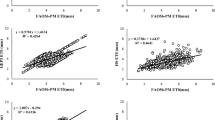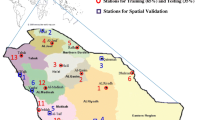Abstract
Evapotranspiration estimation is of crucial importance in arid and hyper-arid regions, which suffer from water shortage, increasing dryness and heat. A modeling study is reported here to cross-station assessment between hyper-arid and humid conditions. The derived equations estimate ET0 values based on temperature-, radiation-, and mass transfer-based configurations. Using data from two meteorological stations in a hyper-arid region of Iran and two meteorological stations in a humid region of Spain, different local and cross-station approaches are applied for developing and validating the derived equations. The comparison of the gene expression programming (GEP)-based-derived equations with corresponding empirical-semi empirical ET0 estimation equations reveals the superiority of new formulas in comparison with the corresponding empirical equations. Therefore, the derived models can be successfully applied in these hyper-arid and humid regions as well as similar climatic contexts especially in data-lack situations. The results also show that when relying on proper input configurations, cross-station might be a promising alternative for locally trained models for the stations with data scarcity.





Similar content being viewed by others
References
Allen RG, Pereira LS, Raes D, Smith M (1998) Crop evapotranspiration. Guidelines for computing crop evapotranspiration. FAO Irrigation and Drainage Paper no. 56, Rome, Italy
Dalton J (1802) Experimental essays on the constitution of mixed gases; on the force of steam of vapour from waters and other liquids in different temperatures, both in a torricellian vacuum and in air on evaporation and on the expansion of gases by heat. Mem Manch Lit Philos Soc 5:535–602
Domingo F, Villagarcía L, Boer MM, Alados-Arboledas L, Puigdefábregas J (2001) Evaluating the long-term water balance of arid zone stream bed vegetation using evapotranspiration modeling and hill slope runoff measurements. J Hydrol 243:17–30
Doorenbos J, Pruitt WO (1977) Crop water requirements. FAO Irrigation and Drainage Paper No. 24, Rome, Italy
Ferreira C (2001) Gene expression programming: a new adaptive algorithm for solving problems. Comp Syst 13(2):87–129
Guven A, Aytek A, Yuce MI, Aksoy H (2008) Genetic programming-based empirical model for daily reference evapotranspiration estimation. Clean Soil, Air, Water 36(10–11):905–912
Hargreaves GH, Allen RG (2003) History and evaluation of Hargreaves evapotranspiration eq. J Irrig Drain Eng 129(1):53–63
Hargreaves GH, Samani ZA (1985) Reference crop evapotranspiration from temperature. Appl Eng Agric 1(2):96–99
Irmak S, Irmak A, Allen RG, Jones JW (2003) Solar and net radiation-based equations to estimate reference evapotranspiration in humid climates. J Irrig Drain Eng 129(5):336–347
Kisi O (2009) Daily pan evaporation modelling using multi-layer perceptrons and radial basis neural networks. Hydrol Process 23:213–223
Kisi O, Pour Ali Baba A, Shiri J (2012) Generalized neuro-fuzzy models for estimating daily pan evaporation values from weather data. J Irrig Drain Eng 138(4):349–362
Landeras G, Ortiz-Barredo A, Lopez JJ (2008) Comparison of artificial neural network models and empirical and semi-empirical equations for daily reference evapotranspiration estimation in the Basque Country (northern Spain). Agric Water Manag 95:553–565
Landeras G, Ortiz-Barredo A, López J (2009) Forecasting weekly evapotranspiration with ARIMA and artificial neural network models. J Irrig Drain Eng 135(3):323–334
Legates DR, McCabe GJ (1999) Evaluating the use of “goodness-of-fit” measures in hydrologic and hydroclimatic validation. Water Resour Res 35(1):233–241
Mahringer W (1970) Verdunstungsstudien am Neusiedler See. Arch Met Geoph Biokl Ser B 18:1–20
Makkink GF (1957) Testing the Penman formula by means of lysimeters. J Inst Water Eng 11(3):277–288
Martí P, Gasque M (2010) Ancillary data supply strategies for improvement of temperature-based ET0 ANN models. Agric Water Manag 97(7):939–955
Martí P, Royuela A, Manzano J, Palau G (2010) Generalization of ETo ANN models through data supplanting. J Irrig Drain Eng 136(3):161–174
Martí P, González-Altozano P, Gasque M (2011) Reference evapotranspiration estimation without local climatic data. Irrig Sci 29(6):469–495
Muñoz DG (2005) Discovering unknown equations that describe large data sets using genetic programming techniques, Master Thesis, Electronic Systems, Linköping Institute of Technology, LITH-ISY-EX-05/3697
Meyer A (1926) U¨ ber einige Zusammenha¨nge zwischen Klima und Boden in Europa. Chem Erde 2:209–347
Parasuraman K, Elshorbagy A, Carey SK (2007) Modelling the dynamics of the evapotranspiration process using genetic programming. Hydrol Sci J 52(3):563–578
Penman WR (1948) Natural evaporation from open water, bare soil and grass. Proc, R Soc Edinburg Sect A, Royal Society Publishing, London 193(1032):120–145
Pour Ali Baba A, Shiri J, Kisi O, Fakheri Fard A, Kim S, Amini R (2013) Estimating daily reference evapotranspiration using available and estimated climatic data by adaptive neuro-fuzzy inference system and artificial neural networks. Hydrol Res 44(1):131–146
Priestley CHB, Taylor RJ (1972) On the assessment of surface heat flux and evaporation using large-scale parameters. Mon Weather Rev 100(2):81–92
Santos JF, Portela MM, Pulido-Calvo I (2014) Spring drought prediction based on winter NAO and global SST in Portugal. Hydrol Process 28(3):1009–1024
Schendel U (1967) Vegetationswasserverbrauch und -wasserbedarf. Habilitation, Kiel, p 137
Singh VP, Xu CY (1997) Evaluation and generalization of 13 mass-transfer equations for determining free water evaporation. Hydrol Process 11:311–323
Shiri J, Kisi O, Landeras G, Lopez JJ, Nazemi AH, Stuyt LCPM (2012) Daily reference evapotranspiration modeling by using genetic programming approach in the Basque Country (northern Spain). J Hydrol 414-415:302–316
Shiri J, Sadraddini AA, Nazemi AH, Kisi O, Marti P, Fakheri Fard A, Landeras G (2013a) Evaluation of different data management scenarios for estimating daily reference evapotranspiration. Hydrol Res 44(6):1058–1070
Shiri J, Nazemi AH, Sadraddini AA, Landeras G, Kisi O, Fakheri Fard A, Marti P (2013b) Global cross station assessment of neuro-fuzzy models for estimating daily reference evapotranspiration. J Hydrol 480:46–57
Shiri J, Marti P, Singh VP (2014a) Evaluation of gene expression programming approaches for estimating daily pan evaporation through spatial and temporal data scanning. Hydrol Process 28(3):1215–1225
Shiri J, Sadraddini AA, Nazemi AH, Kisi O, Landeras G, Fakheri Fard A, Marti P (2014b) Generalizability of gene expression programming-based approaches for estimating daily reference evapotranpiration in coastal stations of Iran. J Hydrol 508:1–11
Shuttleworth WJ (1993) Evaporation. In: Maidment DR (ed) Handbook of hydrology. McGraw-Hill, New York
Trabert W (1896) Neue Beobachtungen u¨ber Verdampfungsgeschwindigkeiten. Meteorol Z 13:261–263
Trajkovic S (2007) Hargreaves versus Penman-Monteith under humid conditions. J Irrig Drain Eng 133(1):38–42
Turc L (1961) Evaluation des besoins en eau d’irrigation evapotranspiration potentielle. Ann Agron 12(1):13–49
UNEP (United Nations Environment Programme) (1992) World atlas of desertification. Edward Arnold, London
UNEP (United Nations Environmental Programme) (1997) World atlas of desertification. Editorial commentary by N. Middleton and D.S.G. Thomas. Edward Arnold, London
WMO (1966) Measurement and estimation of evaporation and evapotranspiration. Tech. Pap. (CIMO-Rep) 83. Genf
Author information
Authors and Affiliations
Corresponding author
Rights and permissions
About this article
Cite this article
Kiafar, H., Babazadeh, H., Marti, P. et al. Evaluating the generalizability of GEP models for estimating reference evapotranspiration in distant humid and arid locations. Theor Appl Climatol 130, 377–389 (2017). https://doi.org/10.1007/s00704-016-1888-5
Received:
Accepted:
Published:
Issue Date:
DOI: https://doi.org/10.1007/s00704-016-1888-5




